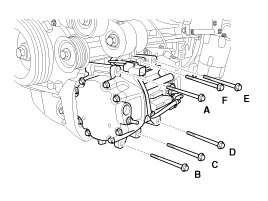Kia Optima Hybrid: Air Conditioning System / Electric A/C compressor Repair procedures
Kia Optima Hybrid (TF HEV) 2016-2020 Service Manual / Heating,Ventilation, Air Conditioning / Air Conditioning System / Electric A/C compressor Repair procedures
| Removal |
| 1. |
If the compressor is marginally operable, run the engine, and
let the air conditioning work for a few minutes, then shut the engine
off. |
| 2. |
Shut off the high voltage circuit.(Refer to Hybrid Control System - High Voltage Shutoff) |
| 3. |
Recover the refrigerant with a recovery/charging station.
|
| 4. |
Loosen the mounting bolts and then remove the under cover(A).
|
| 5. |
Loosen the mounting bolts and clip then remove the wheel house(A).
|
| 6. |
Remove the bolts, then disconnect the suction line (A) and discharge line (B) from the compressor.
Plug or cap the lines immediately after disconnecting them to avoid moisture and dust contamination.
|
| 7. |
Disconnect the compressor low voltage connector and then remove 6 mounting bolts and the compressor(A).
|
| Installation |
| 1. |
Make sure of the length of compressor mounting bolts, and then tighten it A>B>C>D>E>F order.
|
| 2. |
Install in the reverse order of removal, and note these items.
|
| Inspection |
Be sure to read and follow the "General Safety Information
and Caution" before doing any work related with the high voltage system.
Failure to follow the safety instructions may result in serious
electrical injuries. |
| 1. |
Shut off the High Voltage circuit.
(Refer to "High Voltage Shutoff Procedure" in this group) |
| 2. |
Remove the air cleaner assembly and duct.
(Refer to "Intake and Exhaust System" in EM group) |
| 3. |
Drain the coolant of the hybrid motor cooling system and remove the reservoir installed on the HPCU.
(Refer to "Hybrid Motor Cooling System" in HM group). |
| 4. |
Disconnect the coolant inlet hose (A) and outlet hose (B). |
| 5. |
Remove the HPCU protector (C).
|
| 6. |
Disconnect the power cable (A) from the HPCU.
|
| 7. |
Disconnect the motor power cable (A) and HSG power cable (B).
|
| 8. |
Disconnect the electric A/C compressor power cable (A).
|
| 9. |
Measure the capacitors between (+) terminal and (-) terminal of the compressor connector.
|
 Electric A/C compressor Description and Operation
Electric A/C compressor Description and Operation
Description Through the development of electric compressors, fuel efficiency is improved and air conditioner can be implemented when the engine stopped.Operation Principle Compression Part One of the scrolls ...
 Condenser Components and Components Location
Condenser Components and Components Location
Component Location ...
Other information:
Kia Optima Hybrid (TF HEV) 2016-2020 Service Manual: Front Stabilizer Bar Repair procedures
Replacement 1. Remove the front wheel & tire. Tightening torque: 88.3 ~ 107.9N.m(9.0 ~ 11.0kgf.m, 65.1~79.6lb-ft) Be careful not to damage to the hub bolts when removing the front wheel & tire. 2. Loosen the bolt (A) and then disconnect the universal joint assembly from the pinion ...
Kia Optima Hybrid (TF HEV) 2016-2020 Service Manual: Pressure Source Unit Components and Components Location
Components PSU must not be disassembled. 1. Motor connecter2. Bracket3. Block4. Accumulator5. Damper6. Motor ...
© 2025 Copyright www.koptimatfhev.com











